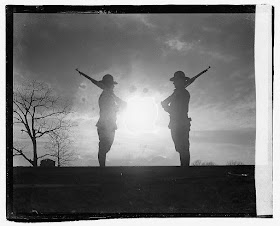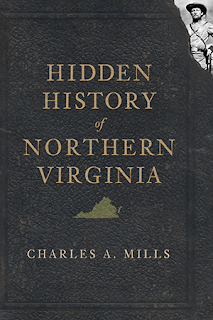The federal government
acquired the Belvoir
Peninsula Engineer School Engineer School Washington ,
needed field training areas and rifle ranges.
The Belvoir
Peninsula
Monday, July 24, 2017
The Creation of Fort Belvoir, Virginia (1918)
Monday, July 17, 2017
The Creation of Quantico Marine Base (World War I)
America entered
World War I in April, 1917. Told to expand its training capabilities, the U.S. Marine
Corps began inspecting promising sites in the spring of 1917. Some five thousand acres along Quantico Creek
in Prince William County, Virginia, were leased from an ailing development
company which had been promoting the area for recreation. The area was largely uninhabited. There
was an officially incorporated town, a shipyard, and a small hotel that had been
built to attract tourists. The first
Marine contingent to arrive consisted of ninety one enlisted men and four
officers. Soon thousands would come
pouring in for training. There were not
enough barracks, and the troops did their laundry in the river. Troops unaccustomed to a Virginia summer
complained, “Quantico was hotter than a pistol and muddier than a pigsty”.
Aviation first arrived at Quantico in July
1918, when two kite balloons were flown to spot artillery fire. Soon four
seaplanes were assigned to Quantico. Naval aviation actually began in 1911,
only six years after the Wright brothers’ first successful flight, with a
Congressional appropriation of $25,000.
This money went for the purchase of three aircraft, one from the Wright
brothers themselves. The first Marine
aviator (he was the fifth Naval aviator) was 1st Lt. Alfred A.
Cunningham. On December 7, 1917, the
Marine aviators were ordered overseas to fight in France, and to take part in
anti-submarine warfare. In 1919, a flying
field was laid out at Quantico and land leased to accommodate a squadron
returning from combat in Europe. The facility was later named Brown Field, in
memory of 2nd Lt Walter V. Brown, who lost his life in an early accident at that
location.
By 1920 Quantico Marine Corps Base had
become a permanent fixture in Northern Virginia, as Marine Corps schools were
founded and the Corps embarked on the mission to, “make this post and the whole
Marine Corps a great university."
Friday, July 14, 2017
The Secrets of Fort Hunt (Alexandria, Virginia)
'Yeah, I speak German like a native,'"
said Dean.
Dean was handed a
nickel and a phone number and then mysteriously dropped off in the middle of Alexandria . Dean went into a drugstore and dialed the
number. A voice on the other end
said, “Dean, you stay outside and we'll
pick you up in a staff car.” Minutes
later he was being driven south toward Mount
Vernon , ending up at Fort Hunt Potomac .
Known only by its’
secret code name “P.O. Box 1142”
throughout the war, Fort Hunt mushroomed into a substantial installation with
one hundred and fifty new buildings, surrounded by guard towers and multiple
electric fences. The intelligence operations being carried out were so secret
that even building plans were labeled "Officers' School" to throw
curious workmen off the scent. Nearby
residents watched unmarked, windowless buses roar toward the fort day and
night.
The Military Intelligence Service (MIS)
had two special operations units working at Fort Hunt
At first, prisoners
were mostly U-boat crew members who had survived the sinking of their
submarines in the Atlantic Ocean . As the war
progressed, P.O. Box 1142 shifted its attention to some of the most prominent
scientists in Germany, many of whom surrendered and gave up information
willingly, hoping to be allowed to stay in the United States. Germany had
superior technology, particularly in rocketry and submarines, and the
information obtained at Fort
Hunt United States
as it moved into the Cold War and the space age. Nearly 4,000 German POWs spent some time in
the camp's 100 barracks. Among the
prisoners were such notables as German scientist Wernher von Braun, who would
become one of America's leading space experts; Reinhard Gehlen, a Nazi
spymaster who would later work for the CIA during the Cold War; and Heinz
Schlicke, inventor of infrared detection.
One of the reasons for secrecy was the fact
that the interrogation operations at Fort
Hunt Fort
Hunt
Although the mere existence of this unit
and its intent violated the Geneva
conventions on POW protocol, extracting information was done without torture,
intimidation or cruelty. The average
stay for a prisoner at Fort
Hunt
Almost all of the American interrogators
were Jewish immigrants from Germany ;
some of whom had lost entire families in the Holocaust. They were recruited to P.O. Box 1142
Only one POW was
shot trying to escape. Lieutenant Commander Werner Henke, the
highest-ranking German officer to be shot while in American captivity during
World War II, was killed while attempting an escape from Fort Hunt in
1944. Henke, the commander of the German
submarine U-515 was captured with forty of his crew on April 9, 1944 when his
U-boat was sunk. The British press had
earlier labelled Henke “War Criminal No. 1”, for machine gunning survivors of
the passenger ship SS Ceramic that
U-515 sank on December 7, 1942. When
interrogators threatened to turn Henke over to the British to face war crime
charges unless he cooperated, Henke attempted an escape and was shot.
The unit also provide support to captured
American POWs in German hands. Packages,
purportedly from loved ones, contained baseballs, playing cards, pipes, and
cribbage boards. Crafted at Fort Hunt,
these innocous items cleverly hid compasses, saws, escape maps, and other
items such as wire cutters.
After the War, Fort Hunt was returned to
the National Park Service which continued to develop the site as a recreational area. All of the buildings connected with the interrogation
center were demolished. Not a
single trace of the Top Secret facility remains except a commemorative plaque
near the flagpole which honors the veterans of P.O. Box 1142
Sunday, July 09, 2017
The Surrender of Lord Cornwallis
Some twenty five years later, Congress commissioned Trumble to paint four large paintings to be hung in the U.S. Capitol rotunda, one of these, The Surrender of Lord Cornwallis was completed in 1820, and depicts the surrender of Lt. General Charles, the Earl Cornwallis at Yorktown on October 19, 1781. Trumbull received $8,000 for the painting (which would be approximately $200,000 in today’s money).
George Washington did
not think that Yorktown would be the last battle of the Revolutionary War, and
felt that it was his duty to keep the Continental Army together until a final
peace treaty was signed. Despite the devastating loss at Yorktown, loyalist
militias continued to fight throughout the back country.
Peace
talks began in April 1782. A preliminary
treaty finally came on November 30, 1782, more than a year after Yorktown. The final treaty was signed on September 3, 1783, and ratified
by the Continental Congress early in 1784.




